TOYOTA VERSO 2015 Owners Manual
Manufacturer: TOYOTA, Model Year: 2015, Model line: VERSO, Model: TOYOTA VERSO 2015Pages: 650, PDF Size: 36.61 MB
Page 451 of 650
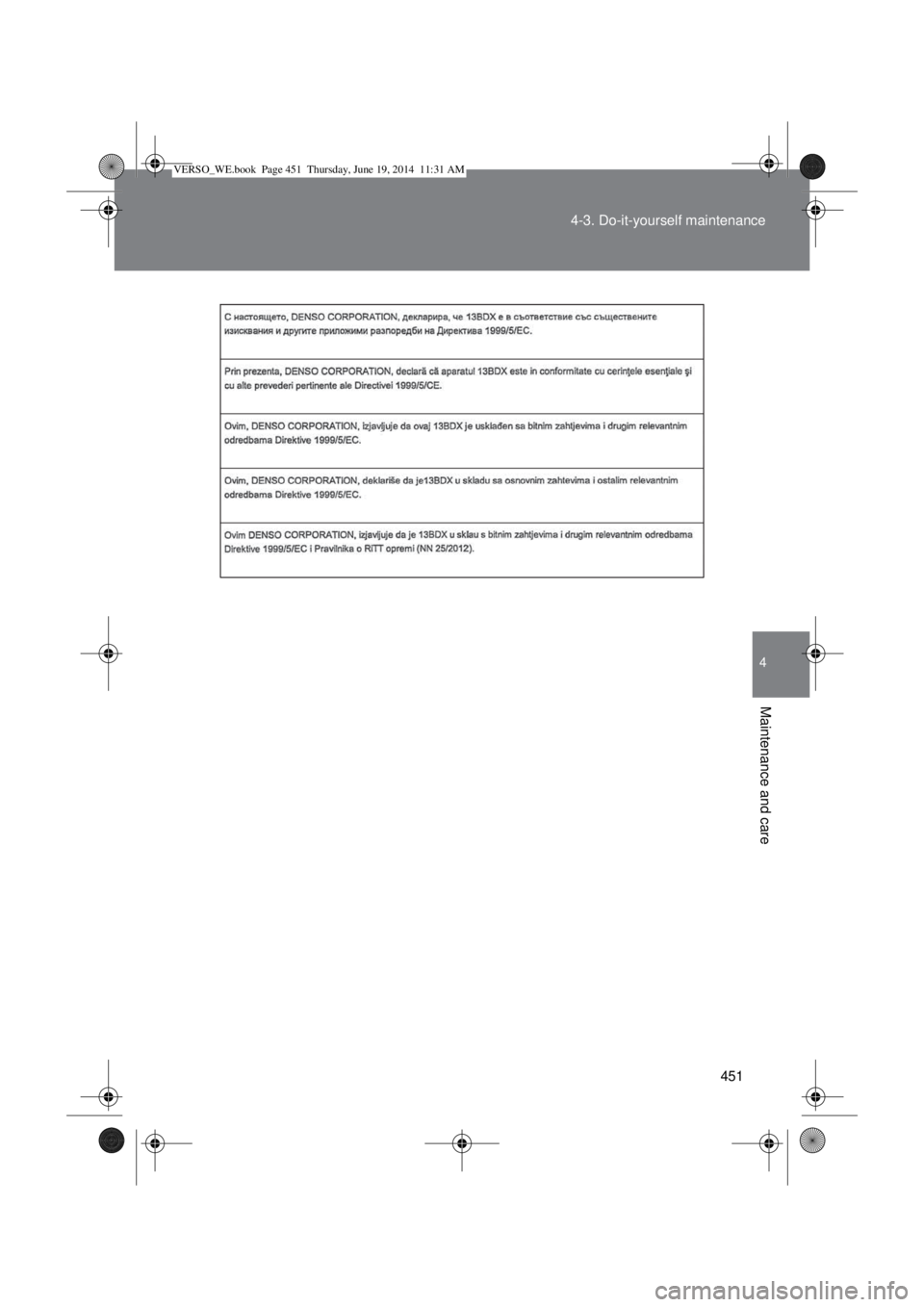
451 4-3. Do-it-yourself maintenance
4
Maintenance and care
VERSO_WE.book Page 451 Thursday, June 19, 2014 11:31 AM
Page 452 of 650
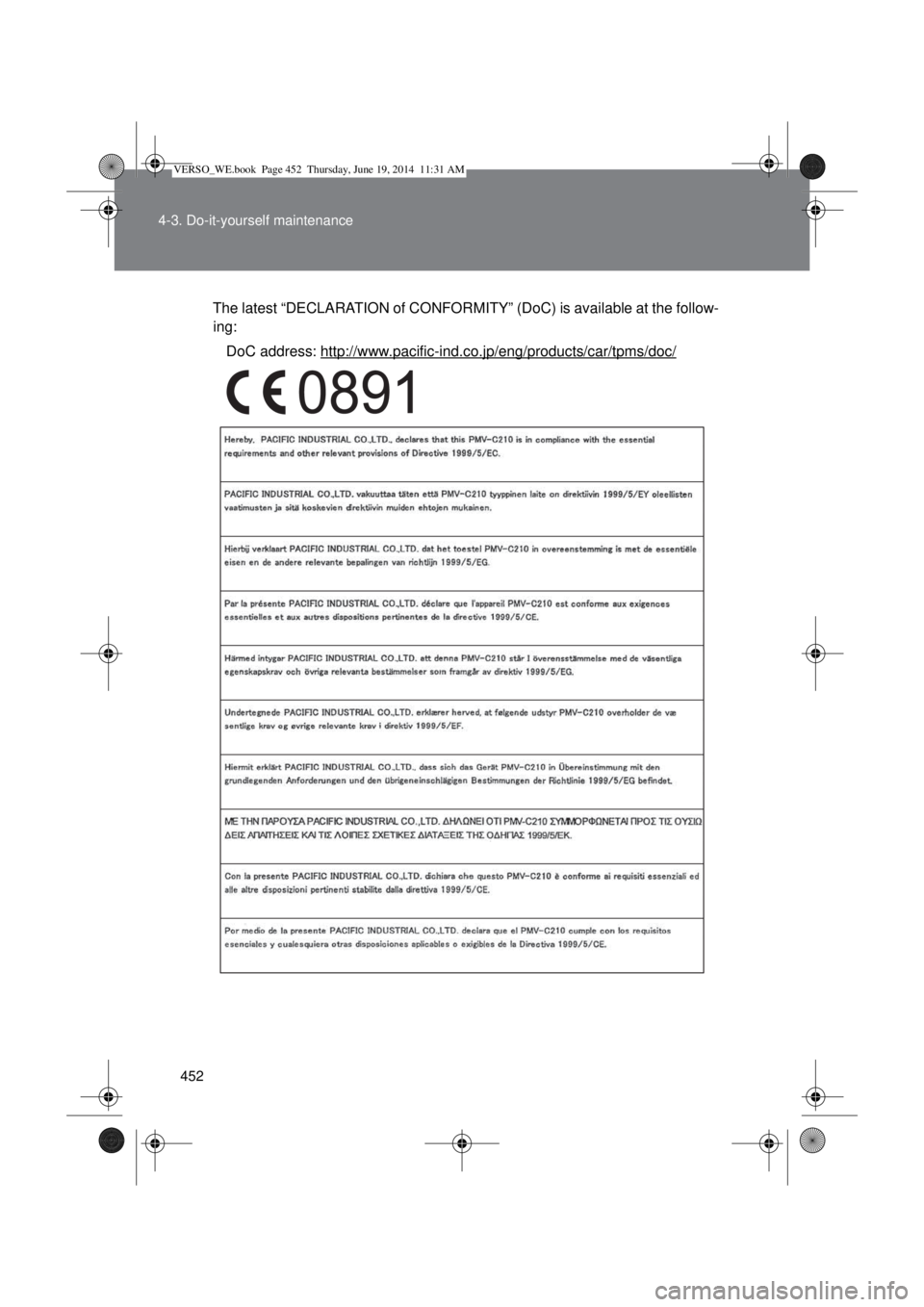
452 4-3. Do-it-yourself maintenance
The latest “DECLARATION of CONFORMITY” (DoC) is available at the follow-
ing:
DoC address:
http://www.pacific-ind.co.jp/eng/products/car/tpms/doc/
VERSO_WE.book Page 452 Thursday, June 19, 2014 11:31 AM
Page 453 of 650
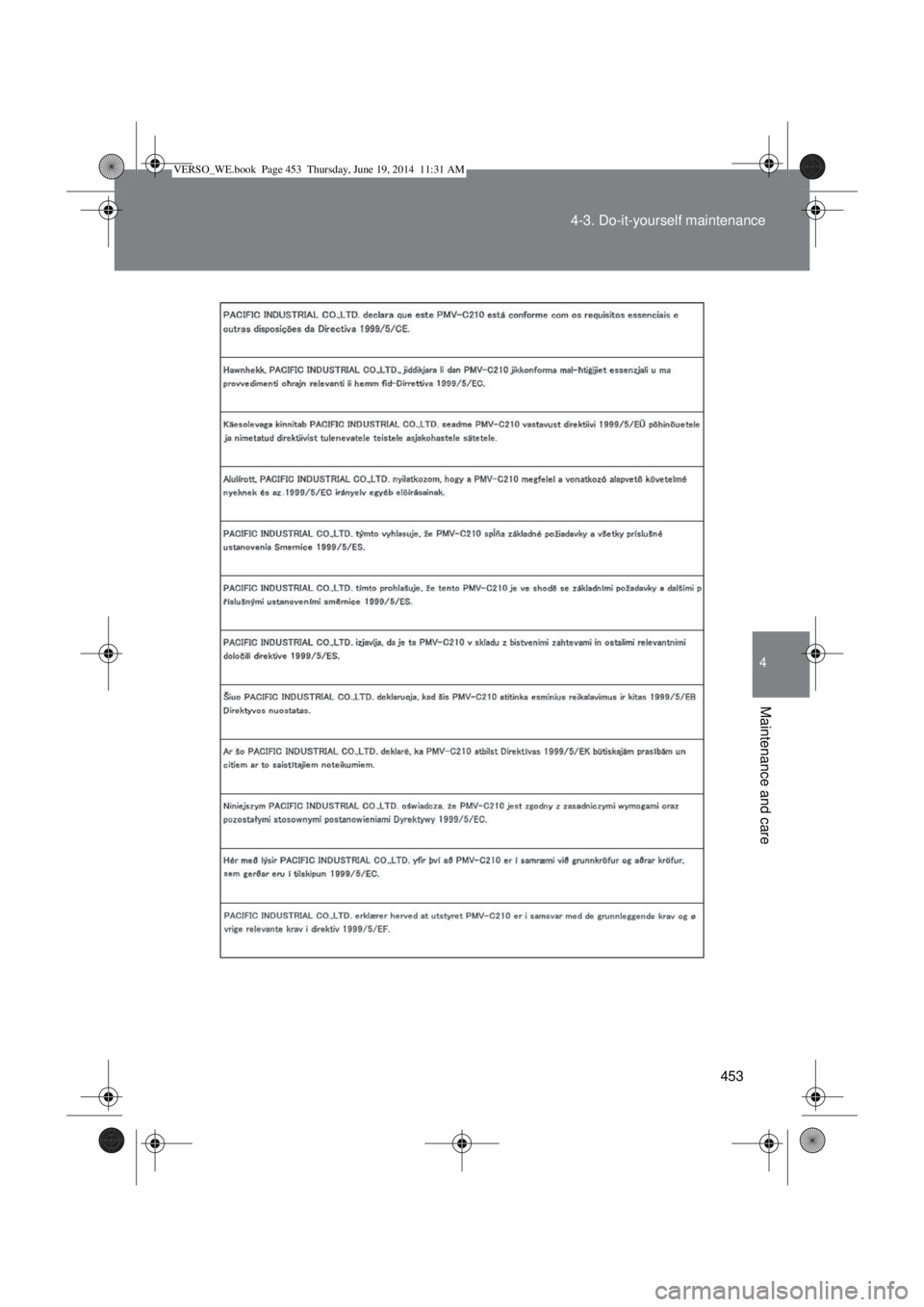
453 4-3. Do-it-yourself maintenance
4
Maintenance and care
VERSO_WE.book Page 453 Thursday, June 19, 2014 11:31 AM
Page 454 of 650
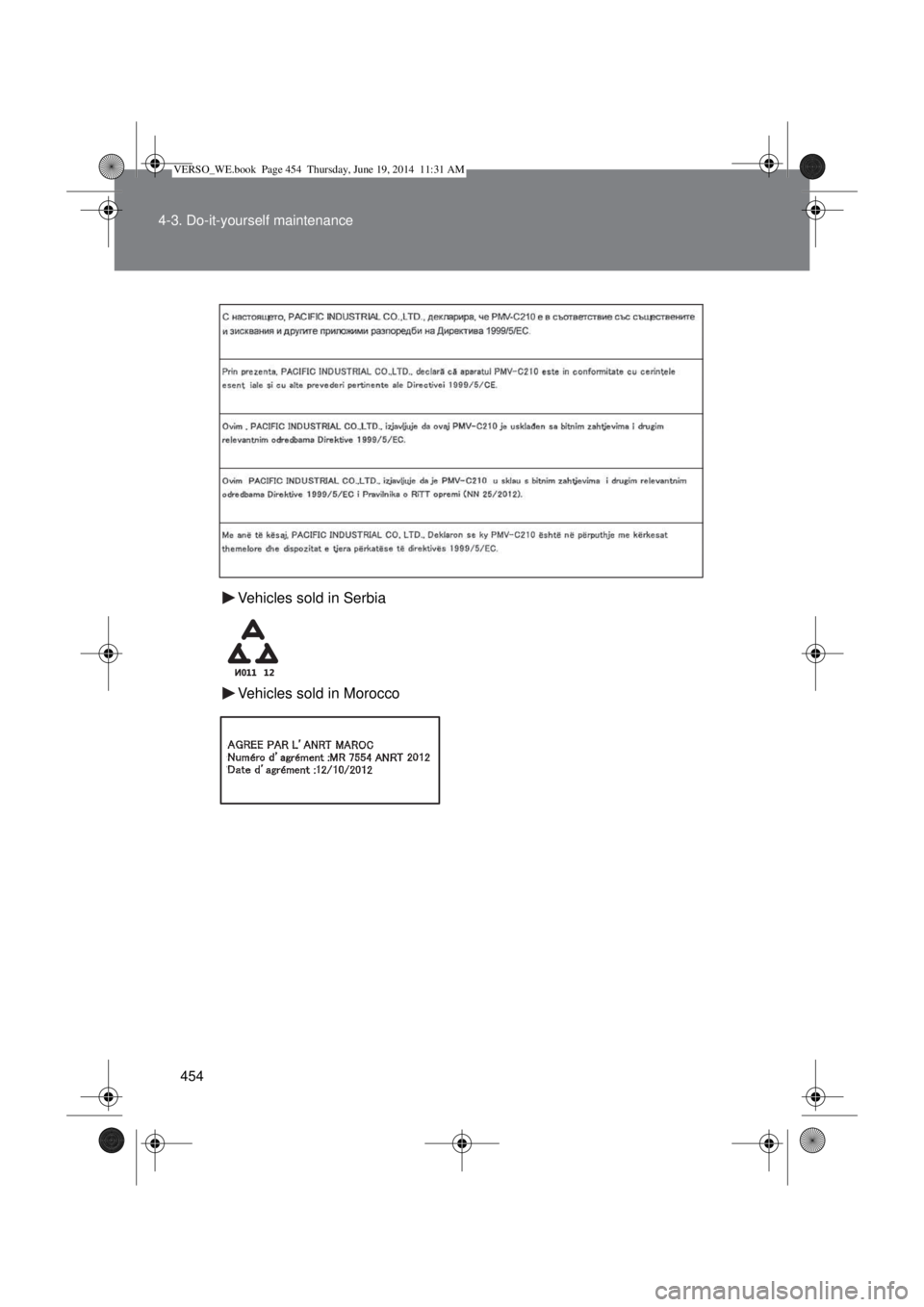
454 4-3. Do-it-yourself maintenance
Vehicles sold in Serbia
Vehicles sold in Morocco
VERSO_WE.book Page 454 Thursday, June 19, 2014 11:31 AM
Page 455 of 650

455 4-3. Do-it-yourself maintenance
4
Maintenance and care
CAUTION
When inspecting or replacing tires
Observe the following precautions to prevent accidents.
Failure to do so may cause damage to parts of the drive train, as well as
dangerous handling characteristics, which may lead to an accident resulting
in death or serious injury.
Do not mix tires of different makes, models or tread patterns.
Also, do not mix tires of remarkably different treadwear.
Do not use tire sizes other than those recommended by Toyota.
Do not mix differently constructed tires (radial, bias-belted or bias-ply
tires).
Do not mix summer, all season and winter tires.
Do not use tires that have been used on another vehicle.
Do not use tires if you do not know how they were used previously.
When initializing the tire pressure warning system (if equipped)
Do not operate the tire pressure warning reset switch without first adjusting
the tire inflation pressure to the specified level. Otherwise, the tire pressure
warning light may not come on even if the tire inflation pressure is low, or it
may come on when the tire inflation pressure is actually normal.
VERSO_WE.book Page 455 Thursday, June 19, 2014 11:31 AM
Page 456 of 650

456 4-3. Do-it-yourself maintenance
NOTICE
Repairing or replacing tires, wheels, tire pressure warning valves,
transmitters and tire valve caps (vehicles with the tire pressure warn-
ing system)
When removing or fitting the wheels, tires or the tire pressure warning
valves and transmitters, contact any authorized Toyota dealer or repairer,
or another duly qualified and equipped professional as the tire pressure
warning valves and transmitters may be damaged if not handled correctly.
Make sure to install the tire valve caps. If the tire valve caps are not
installed, water could enter the tire pressure warning valves and the tire
pressure warning valves could be bound.
When replacing tire valve caps, do not use tire valve caps other than those
specified. The cap may become stuck.
To avoid damage to the tire pressure warning valves and transmitters
(vehicles with the tire pressure warning system)
When a tire is repaired with liquid sealants, the tire pressure warning valve
and transmitter may not operate properly. If a liquid sealant is used, contact
any authorized Toyota dealer or repairer, or another duly qualified and
equipped professional or other qualified service shop as soon as possible.
Make sure to replace the tire pressure warning valve and transmitter when
replacing the tire. (P. 444)
Driving on rough roads
Take particular care when driving on roads with loose surfaces or pot holes.
These conditions may cause losses in tire inflation pressure, reducing the
cushioning ability of the tires. In addition driving on rough roads may cause
damage to the tires themselves, as well as the vehicle’s wheels and body.
If tire inflation pressures become low while driving
Do not continue driving, or your tires and/or wheels may be ruined.
VERSO_WE.book Page 456 Thursday, June 19, 2014 11:31 AM
Page 457 of 650
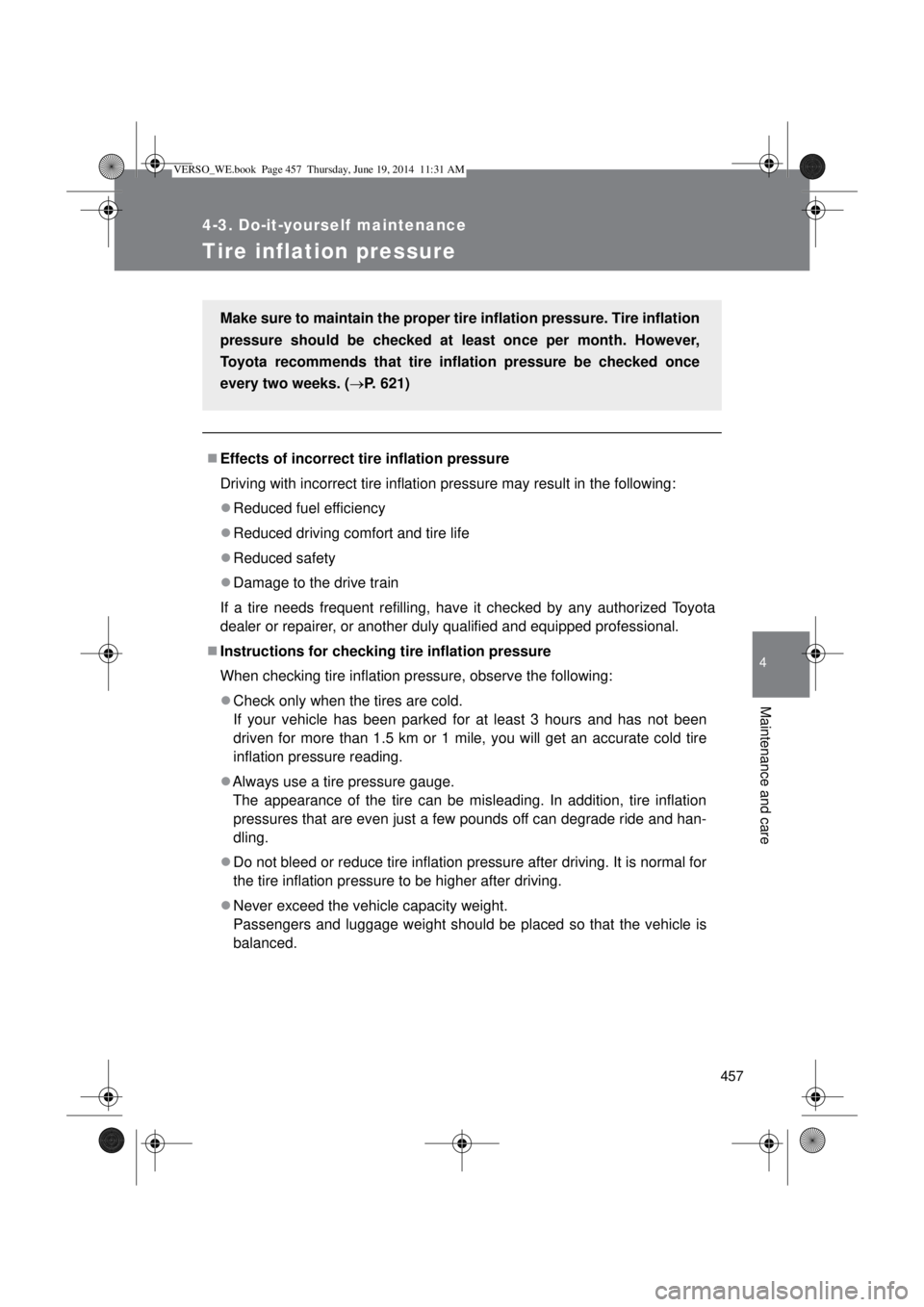
457
4-3. Do-it-yourself maintenance
4
Maintenance and care
Tire inflation pressure
Effects of incorrect tire inflation pressure
Driving with incorrect tire inflation pressure may result in the following:
Reduced fuel efficiency
Reduced driving comfort and tire life
Reduced safety
Damage to the drive train
If a tire needs frequent refilling, have it checked by any authorized Toyota
dealer or repairer, or another duly qualified and equipped professional.
Instructions for checking tire inflation pressure
When checking tire inflation pressure, observe the following:
Check only when the tires are cold.
If your vehicle has been parked for at least 3 hours and has not been
driven for more than 1.5 km or 1 mile, you will get an accurate cold tire
inflation pressure reading.
Always use a tire pressure gauge.
The appearance of the tire can be misleading. In addition, tire inflation
pressures that are even just a few pounds off can degrade ride and han-
dling.
Do not bleed or reduce tire inflation pressure after driving. It is normal for
the tire inflation pressure to be higher after driving.
Never exceed the vehicle capacity weight.
Passengers and luggage weight should be placed so that the vehicle is
balanced. Make sure to maintain the proper tire inflation pressure. Tire inflation
pressure should be checked at least once per month. However,
Toyota recommends that tire inflation pressure be checked once
every two weeks. (P. 621)
VERSO_WE.book Page 457 Thursday, June 19, 2014 11:31 AM
Page 458 of 650

458 4-3. Do-it-yourself maintenance
CAUTION
Proper inflation is critical to save tire performance
Keep your tires properly inflated. Otherwise, the following conditions may
occur and result in an accident causing death or serious injury.
Excessive wear
Uneven wear
Poor handling
Possibility of blowouts resulting from overheated tires
Poor sealing of the tire bead
Wheel deformation and/or tire separation
A greater possibility of tire damage from road hazards
NOTICE
When inspecting and adjusting tire inflation pressure
Be sure to reinstall the tire valve caps.
Without the valve caps, dirt or moisture could get into the valve and cause
air leakage, which could result in an accident. If the caps have been lost,
replace them as soon as possible.
VERSO_WE.book Page 458 Thursday, June 19, 2014 11:31 AM
Page 459 of 650
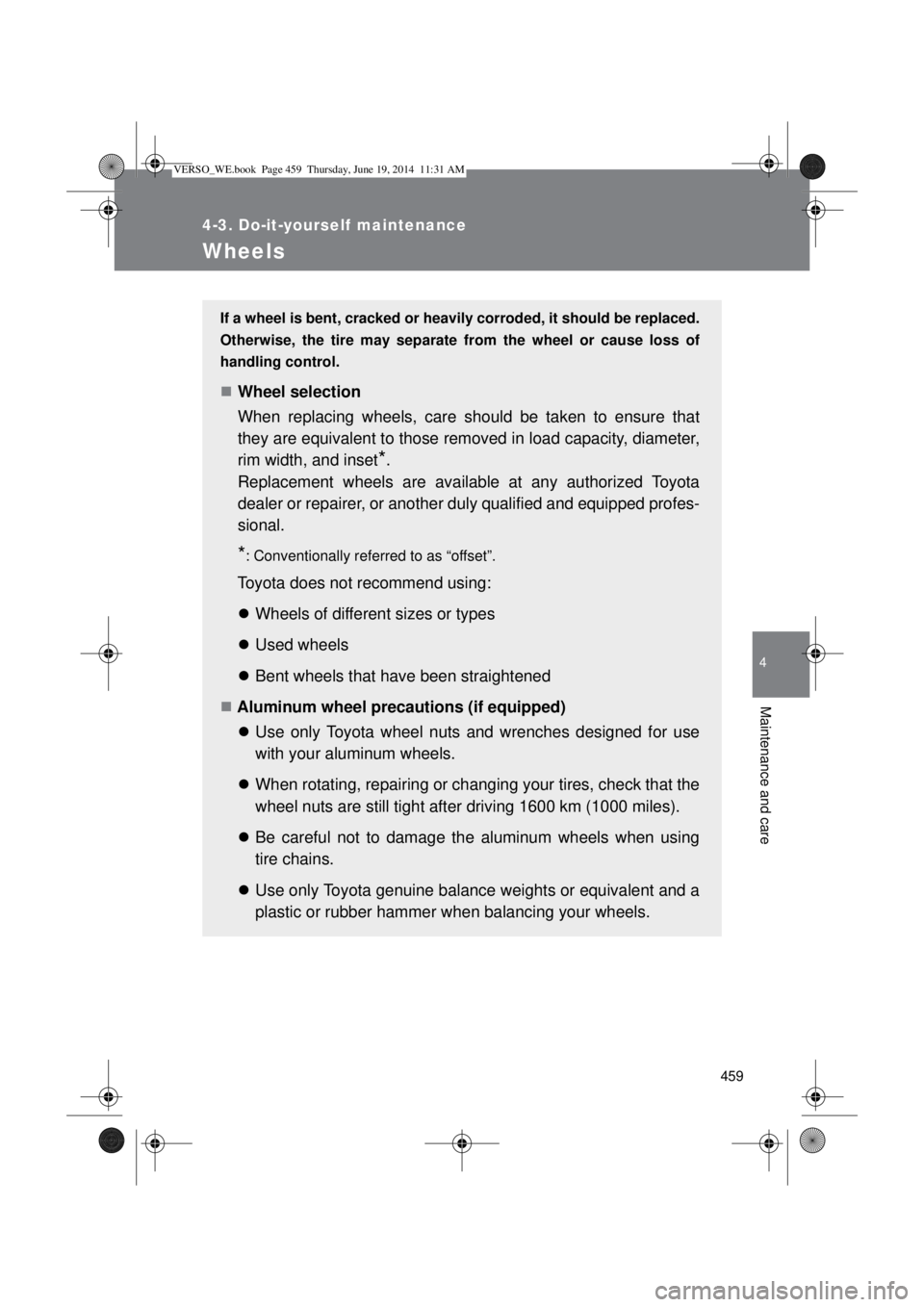
459
4-3. Do-it-yourself maintenance
4
Maintenance and care
Wheels
If a wheel is bent, cracked or heavily corroded, it should be replaced.
Otherwise, the tire may separate from the wheel or cause loss of
handling control.
Wheel selection
When replacing wheels, care should be taken to ensure that
they are equivalent to those removed in load capacity, diameter,
rim width, and inset
*.
Replacement wheels are available at any authorized Toyota
dealer or repairer, or another duly qualified and equipped profes-
sional.
*: Conventionally referred to as “offset”.
Toyota does not recommend using:
Wheels of different sizes or types
Used wheels
Bent wheels that have been straightened
Aluminum wheel precautions (if equipped)
Use only Toyota wheel nuts and wrenches designed for use
with your aluminum wheels.
When rotating, repairing or changing your tires, check that the
wheel nuts are still tight after driving 1600 km (1000 miles).
Be careful not to damage the aluminum wheels when using
tire chains.
Use only Toyota genuine balance weights or equivalent and a
plastic or rubber hammer when balancing your wheels.
VERSO_WE.book Page 459 Thursday, June 19, 2014 11:31 AM
Page 460 of 650
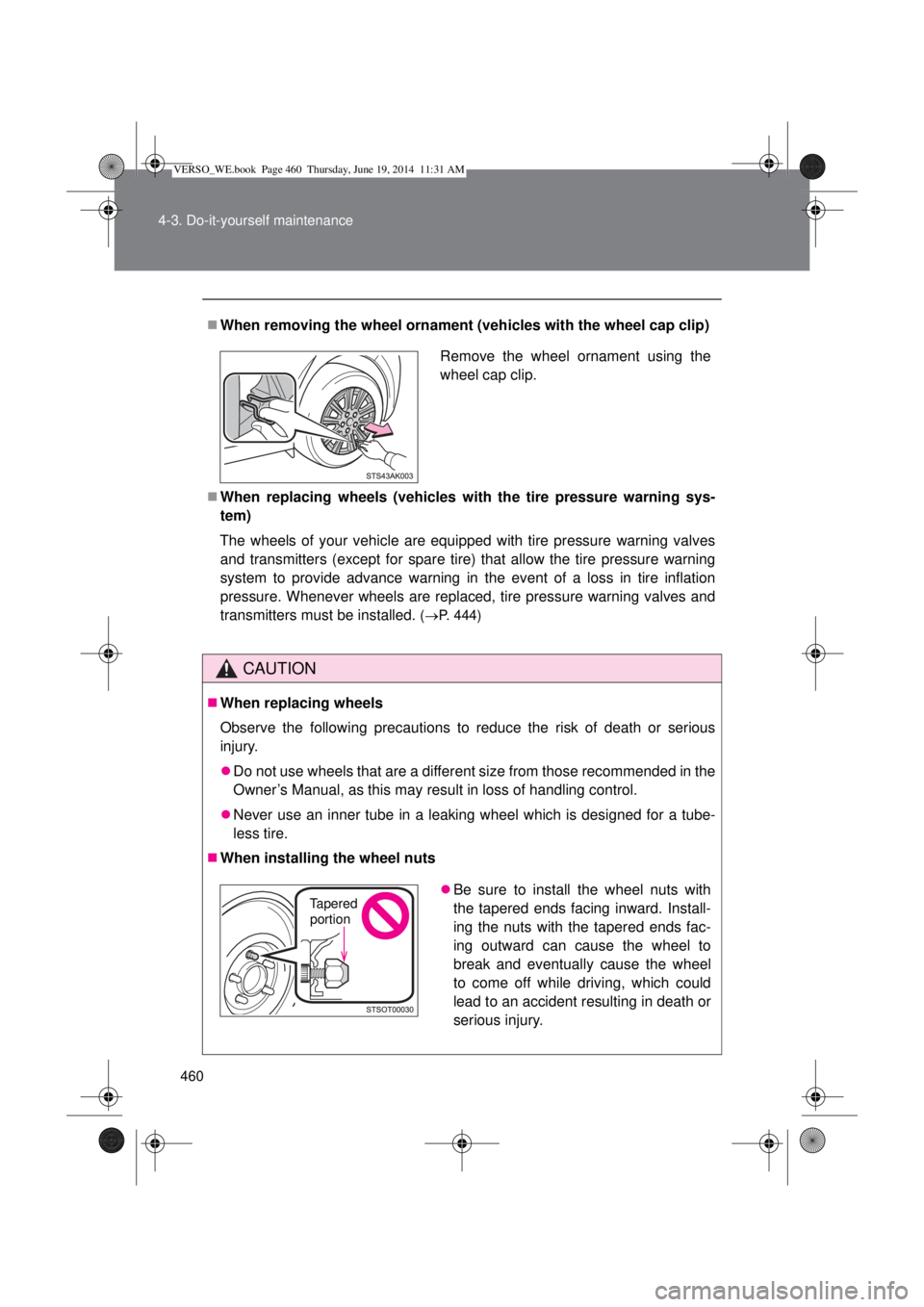
460 4-3. Do-it-yourself maintenance
When removing the wheel ornament (vehicles with the wheel cap clip)
When replacing wheels (vehicles with the tire pressure warning sys-
tem)
The wheels of your vehicle are equipped with tire pressure warning valves
and transmitters (except for spare tire) that allow the tire pressure warning
system to provide advance warning in the event of a loss in tire inflation
pressure. Whenever wheels are replaced, tire pressure warning valves and
transmitters must be installed.
(P. 444)
CAUTION
When replacing wheels
Observe the following precautions to reduce the risk of death or serious
injury.
Do not use wheels that are a different size from those recommended in the
Owner’s Manual, as this may result in loss of handling control.
Never use an inner tube in a leaking wheel which is designed for a tube-
less tire.
When installing the wheel nuts
Remove the wheel ornament using the
wheel cap clip.
Be sure to install the wheel nuts with
the tapered ends facing inward. Install-
ing the nuts with the tapered ends fac-
ing outward can cause the wheel to
break and eventually cause the wheel
to come off while driving, which could
lead to an accident resulting in death or
serious injury.Tapered
portion
VERSO_WE.book Page 460 Thursday, June 19, 2014 11:31 AM